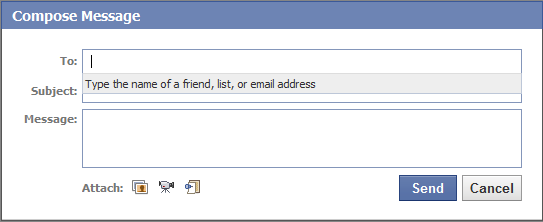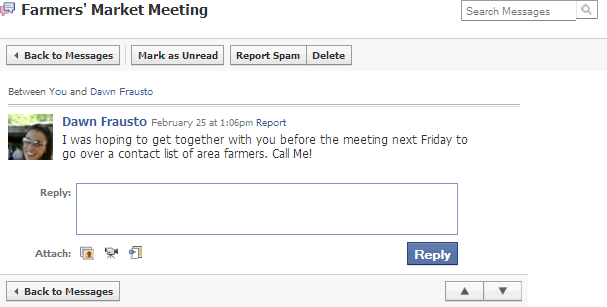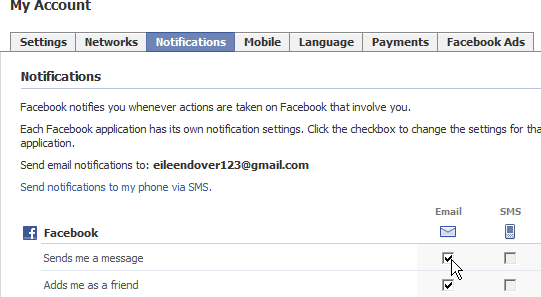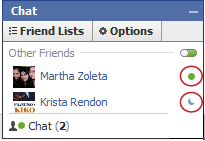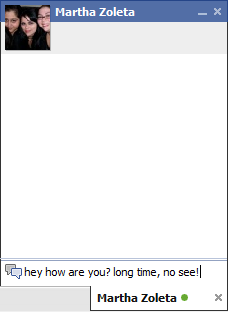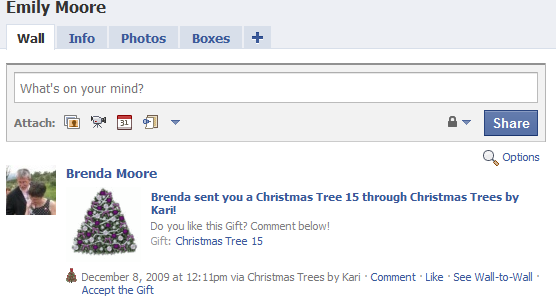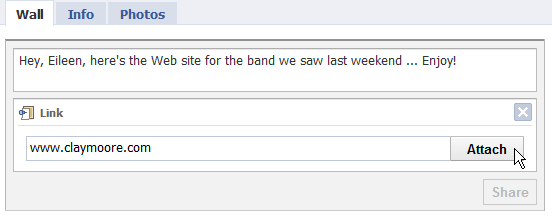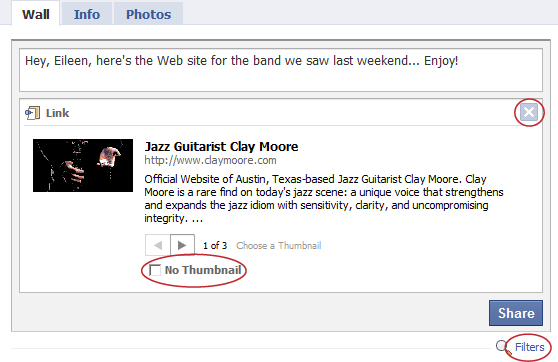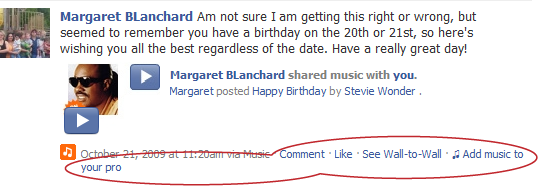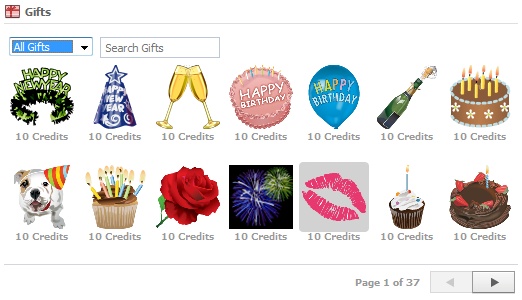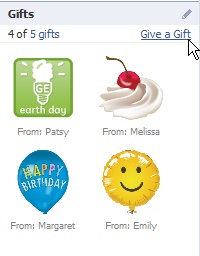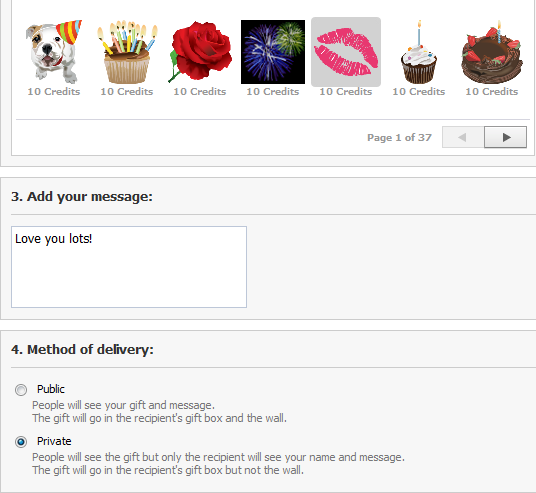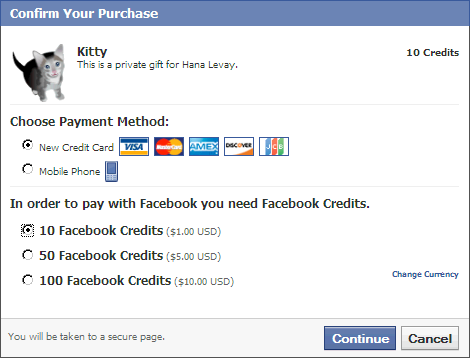Chapter 4. Sending Messages to Friends
Just like your email program, Facebook lets you send private messages to other Facebook members. “Great,” you’re probably thinking, “just what I need: yet another inbox to check.” But before you skip to the next chapter, you might want to give these tools a chance.
First off, Facebook makes exchanging messages dead simple—even easier than regular email. And then there are the slightly zany—but slightly addictive—ways to keep in touch with others that no email program can match. In an effort to mimic the different ways we interact with people in real life, Facebook lets you poke (give a virtual “Hey, how ya doin'?” wave to) friends; write on their virtual message boards; and send silly digital gifts. Even if you’re not persuaded by any of this, it’s still worth understanding the messaging system since, soon enough, you’ll no doubt get a Facebook message from one of your friends.
Sending Messages
Lots of websites offer free Web-based email, and Facebook is one of them—sort of. As a Facebook member, you can send private messages to any other Facebook member (whether or not they’re on your Friend List), and to regular email addresses. But only other Facebook members can send you Facebook messages. In other words, when you register for Facebook, you don’t get a YourName@Facebook.com email account; people have to sign up for Facebook and follow the steps below if they want to send a message to your Facebook inbox.
Sending Messages to Friends
Most of the messages you send, of course, will be to people you already know. Facebook gives you a simple set of tools that will look familiar to anyone who’s used email before. Here’s what you do:
At the top of any Facebook screen, click the icon that looks like two speech bubbles, and then in the drop-down menu that appears, click the “Send a New Message” link. Or, if you’re on your Home page, click Messages link on the left side of the screen and then click the “+ New Message” button on the right side of the page that appears. Either way, Facebook displays the New Message box.
In the “To:” field of the Compose Message box, start typing your friend’s name (if she’s a Facebook member), email address (for non-Facebook members), or the name of a Friend List (Confirming Requests in Facebook). As soon as you begin typing, Facebook displays a list of your friends and Friend Lists. To select a name, click it or use the up and down arrow keys to select the name, and then hit Enter. If you’re sending a message to a non-Facebook member, simply type in the person’s full email address. You can add multiple recipients, if you like; just click after you enter each one and then start typing again. (See Sending a Message to More Than One Person for more on sending messages to multiple people.)
Why would you want to use Facebook to send a message to someone who’s not a Facebook member? Two reasons: First, you’re already in Facebook and don’t have to waste time switching over to your email program (or can’t, if you’re using someone else’s computer). Second, you want to lure this non-member friend into your Facebook social circle by giving her a taste of Facebook’s coolness. When your friend clicks the Facebook-generated “Click to Reply” link in your email, she’s whisked to a Facebook page she can use to preview Facebook messaging, as well as to get more info and sign up.
Fill in the “Subject:” field and then type your message. If you want to pass along a link to a website (or to a photo or video on the Web), mouse down to the Attach section and click the photo, video, or link icon. When you finish, click Send.
If a security box like the one on Signing Up for an Account appears, type in the security words you see and then click Submit. Facebook sends your message and stores a copy in your Sent messages, which you can view by heading to your Home page, clicking the Messages link on the left, and then clicking the Sent link that appears below it.
Sending Messages to People You’re Not (Yet) Friends With
Facebook lets you send a message to any Facebook member, even if she’s not on your Friend List and doesn’t belong to any of your networks.
Note
There’s one exception to this rule: If a Facebook member blocks you (Fighting Back), you can’t contact him on Facebook—by sending him a message, poking him, or any other way.
To send a message to a non-friend Facebook member:
Head to either the profile of the person you want to contact, or the person’s listing on your search page (Finding Friends).
Click either the “Send [Name] a Message” link (which you find on a person’s profile below their picture) or the “Send a Message” link (which you find in search results). Whichever link you click, up pops the Compose Message box shown on Sending Messages to People You’re Not (Yet) Friends With. Simply type your message and send it off as explained in the previous section.
Sending a Message to More Than One Person
Because Facebook was designed to help people communicate online just as they do offline, the site makes it easy to send a message to an individual—but a little harder to send the same message to dozens of people all at once. If you go too far down that path, the Facebook design team reasoned, you’re talking spam. After all, how often do you whip out a bullhorn and address a real-life crowd of dozens?
Facebook decided to cap the number of people you can send a message to at 20, so you can use the basic message-sending instructions on Sending Messages and type in a combination of Facebook friends’ names and email addresses to send your message to up to 20 people. Another option is to create a Friend List (Creating a Friend List) containing all the people you want to send the message to. Then, on the Compose Message box, head to the “To:” field and type the name of the list. But if you try to send a message to a Friend List that includes more than 20 people, Facebook will display a “Cannot add list” message and remind you of its 20-person limit.
Note
An exception to the no-spam rule is that Facebook lets you send the same message to every member of a Group (Chapter 6)—although even then, Facebook theoretically caps the number of recipients at 5,000. (The cap is theoretical because some Facebook members have had their accounts suspended for sending messages to a lot fewer than 5,000 people.)
Receiving Messages
When someone sends you a message via Facebook, two things happen:
You receive the message in your Facebook inbox. To alert you that you have a message, Facebook displays a little red box above the Messages icon at the top left of any Facebook screen (the icon is just to the right of the word “facebook”). To open your inbox, head to the top of your screen and click the Messages icon, then click See All Messages; if you’re on your Home page, you can also click the Messages link on the left side of the screen. Then click either the subject line or the first line of any message to see it in its entirety.
You receive the message in your regular email program. Facebook sends the message to your primary email address.
Note
Your primary email address is the one you used when you registered for the site (unless you’ve changed it since then). To change your primary email address, at the top of any Facebook screen, mouse over Settings and choose Account Settings; on the screen that appears, click Email.
Tip
If you spend a lot of time on the site and regularly check your Facebook inbox, you don’t really need to have Facebook messages sent to your regular email address, too. To make it so you only receive Facebook messages in your Facebook inbox, head to the Email Notifications page (to get there, simply click the “Want to control which emails you receive from Facebook?” link at the bottom of any email Facebook sent to your regular email address) and turn off the checkbox next to “Sends me a message”.
Viewing Your Facebook Inbox
It’s easy to tell if you have a new Facebook message even without opening your inbox. Just take a look the blue menu bar at the top of any Facebook screen. If you see a red number right above the icon that looks like two little speech bubbles (it’s the second icon to the right of the word “facebook”), you’ve got a new message (or two, or more). Click that icon and a list of your most recent messages appears. To see your full inbox, click the See All Messages link at the bottom of the list.
Facebook puts a big blue dot in front of any message you haven’t read yet, and highlights the entire listing in light blue. Facebook automatically lists all your messages, even ones you’ve already read. If you only want to see the ones you haven’t read, click the word “Unread” in the upper-right part of your screen. Clicking a sender’s name or picture shoots you directly to that person’s profile, which is handy if you don’t recognize him.
Reading and Responding to Messages
To read a message in your inbox, click either the subject line or first line of the message and Facebook displays the whole message.
Tip
A particularly cool feature of Facebook’s inbox is that when you display a message that’s the latest in a long, drawn-out, back-and-forth thread, Facebook zips you down to the most recent message so you don’t have to read through the long list of exchanges and hunt for the latest one.
To reply to the message, simply type your response in the Reply box, and then click Send. To delete the message without replying, click the Delete button near the top of your screen.
Chatting
Facebook’s built-in chat feature lets you send messages to friends who are online when you are. Because chat messages—unlike regular Facebook messages—pop up on your friends’ screens immediately after you send them, they’re handy for exchanging quick updates. (“Hey, we still meeting for lunch in 5 minutes?” “Yeah, I’m headed out the door now!”)
To send a chat message:
At the bottom right of any Facebook screen, click the
 button. The number that appears in parentheses beside
the word “Chat” tells you how many of your Facebook friends are currently logged into
the site (and, therefore, how many folks you can potentially send chat messages
to).
button. The number that appears in parentheses beside
the word “Chat” tells you how many of your Facebook friends are currently logged into
the site (and, therefore, how many folks you can potentially send chat messages
to).In the Chat window that appears, click the name of the friend you want to chat with. A green dot beside a person’s name means that person is logged in and active. A green crescent moon means the person is logged into Facebook, but hasn’t typed anything in a few minutes (and so may be out getting a cup of coffee).
In the person-to-person window that appears, type in your message and then hit Enter. As soon as you do, your message appears on you friend’s screen in a similar person-to-person chat window.
Send additional chat messages, if you want, by repeating step 3. When you’re finished with your conversation, you can hide the chat window by clicking anywhere on the blue bar that runs across the top of it.
Note
Because chat messages can pop up on your screen, they can be seriously annoying. To keep super-chatty folks from being able to chat with you, put them on a list (Organizing Your Friends) named, say, SuperChatties. Then, in the Chat box (at the bottom of any Facebook screen, click Chat), click the Friend Lists tab and make sure the checkbox next to the SuperChatties list is turned on. Then when SuperChatties appears in the chat box, click the green-and-white Go Offline icon (it looks like a capsule on its side) to the right of the list’s name. Doing so hides the fact that you’re online and, therefore, “chattable” from everyone on the SuperChatties list and changes the green-and-white Go Offline icon to a grey-and-white Go Online icon (which you can click when you’re in the mood to field one of those long-winded conversations). If you don’t feel like chatting with anyone, in the Chat window, click the Options tab and then click Go Offline.
When someone sends you a chat message, Facebook plays a sound and up pops the Chat window, where you see the sender’s profile picture along with their message. To reply, simply type your message in the bottom of the window and hit Enter.
Tip
You can customize the Chat window so that it stays up all the time instead of popping up, and so that it doesn’t play a sound every time someone chats at you—both of which are useful if you expect to do a lot of chatting. In the Chat window (at the bottom of any Facebook screen, click Chat), click Options. Then turn off the checkbox next to “Play Sound for New Messages” and turn on the checkbox next to “Keep Online Friends Window Open”.
Poking
Poking sounds a lot more provocative than it is. Giving someone a poke in Facebook is nothing more than the electronic equivalent of asking someone, “Hey, what’s up?” Pokes appear as a “You were poked by [name]” message on the recipient’s Home page.
Tip
Poking—like sneaking up behind someone and tapping her shoulder—isn’t really good for much beyond the yuk factor. Depending on you and your pals’ tolerance for friendly nudging, poking either gets the award for Silliest Social Aid or Most Annoying Thing Ever. If you’re in the latter camp, you’ll find notifications (Customizing Your Mini Feed) similar but more useful.
Note
You can poke any Facebook member—you don’t have to be friends with the pokee or belong to the same network. But if you poke someone who doesn’t normally have access to your profile, be aware that he’ll be able to see the basic, work-, and education-related portions of your profile for a week post-poke. But letting a pokee see your profile is rarely a problem. After all, if you’re that worried somebody might discover your passion for the Bay City Rollers, you shouldn’t poke him in the first place.
To poke someone:
Find the person you want to poke by viewing your Friend List (Viewing a Friend List) or using Facebook’s Search box (Finding Friends).
Click the “Poke [name]” link on the person’s profile (Finding People Who Are Facebook Members). The link is below the person’s picture.
In the confirmation box that appears, click Poke. You briefly see a “You have poked [name]” message, and the damage is done: Your poke message appears on the pokee’s Home page, complete with a link she can use to poke you back.
Writing on Walls
One of the sections on every Facebook member’s profile is a forum called the Wall. A Wall is a place for your Facebook pals to share interesting photos, videos, websites, and character insights. By default, the only people’s Walls you can write on are your own and your friends’. But since Walls are part of profiles, anyone who can view your profile can see your Wall messages. You can think of Walls as a 21st-century version of the dry-erase message boards they used to have in dorm rooms: an informal place to brag, tease, show solidarity, get attention, and occasionally impart useful information.
Tip
You can find several Facebook applications (such as FunWall, SuperWall, and Graffiti) that let you add photos, video clips, and even virtual spray paint to your friends’ Walls. Flip to Facebook Applications: An Overview to learn about applications.
Note
Because friendly jokes can sometimes get out of hand, Facebook lets you remove any Wall posts you don’t like (Responding to a Wall Post) and restrict who can see your Wall (Controlling Who Sees Your Profile and Contact Info).
Writing on a Friend’s Wall
Writing on someone’s Wall is a more public way of expressing yourself than sending your friend a message, because all your friend’s friends will see your Wall post (unless you remember to tell Facebook to keep it between you and your friend, as explained on Writing on a Friend’s Wall). Good candidates for Wall posts include thanks, congratulations, birthday greetings, and other tidbits your shared connections might find interesting or useful.
Tip
To write on your own Wall, follow the steps below, but start at your own profile instead of a friend’s. If you like, you can adjust who sees the stuff you put on your own Wall by clicking the Options link (look just below the Share button on your profile) and then clicking Settings.
To write on a friend’s Wall:
On your friend’s profile, make sure the Wall tab is selected. You should see a text box that says “Write something…” If you don’t see the text box, you’re out of luck: Your friend has restricted access to her Wall.
Type your message in the text box.
If you want to upload a photo or video, send a gift (Sending Gifts), or add a link to a website, head to the Attach section and click the icon for what you want to add. (Mouse over each icon for a quickie description.) Depending on which icon you click, Facebook displays additional fields and instructions for completing your attachment.
If you decided to share a link, choose which thumbnail you want to accompany your link. Facebook pulls a site description and a handful of thumbnails from the site for you to choose from. To check out the various thumbnails, click the arrow buttons that appear. To skip the graphic, turn on the No Thumbnail checkbox.
Optionally, tell Facebook who you want to let view your message. Ordinarily, your message can be viewed by your friend as well as all her friends, but you can restrict access to just your friend (or just her friends) by clicking the Filters link.
Click Share. Your message appears on your friend’s Wall.
Note
Some Facebook applications (Facebook Applications: An Overview) let you attach other stuff to the messages you post on people’s Walls. The Graffiti application, for example, lets you decorate your friend’s Wall with virtual spray paint.
Responding to a Wall Post
When someone writes on your Wall, you can have a chuckle and leave it at that—or you can respond in one of the following ways:
Write something on the poster’s Wall. Clicking the "See Wall-to-Wall” link below the person’s post displays a history of your and your friend’s posts to each other’s Walls, and lets you add a new post.
Respond to the post on your own Wall. Clicking the Comment link skips the back-and-forth history and just lets you type in your response. Clicking Like adds your name—accompanied by a thumbs-up icon—to the post.
Delete the post. You can delete any post from your own Wall, no matter who posted it. To do so, mouse over the post until the Remove link appears on the right side of the post, click Remove, and then click Delete in the confirmation box.
Sending Gifts
A Facebook gift is a virtual greeting card–style icon you can send to someone, accompanied by a personal message. You can choose from hundreds of professionally designed graphics, most of them of the smiley-face-and-teddy-bear variety. After you send a gift, it appears on the recipient’s profile—in the Gifts section, on the recipient’s Wall, or both, depending on whether you decide to make the gift public or private.
Note
The occasional exchange of gifts is part of what of what makes any good relationship tick—online and off. In recognition of this, Facebook has made it easy for members to give each other not just virtual gifts, but music clips, charitable-donations-in-the-name-of gifts, and even actual, physical gifts (think chocolate!).
Facebook charges for its gifts in credits. Currently, one Facebook credit will set you back ten cents, and the average virtual gift costs 10 credits ($1); you pay by entering your credit card or cellphone number at the end of the gift-giving process. (Real-life gifts, as you may have guessed, run anywhere from a bit to a lot pricier.) To get around the $1 price tag for virtual gifts, check out the Free Gifts application (see Facebook Applications: An Overview).
Note
As this book went to press, there were rumors that you’d soon be able to pay for Facebook credits using PayPal, so don’t be surprised if you see that option, too.
To send someone a Facebook gift:
On your profile, scroll down until you see the Gifts section (you may have to click the blue Gifts header to see the whole Gifts section), and then click “Give a Gift”.
Note
If you don’t see a Gifts section on your profile, head to www.facebook.com/giftshop.php.
On the page that appears, start typing in the “Choose your recipient” field and then, from the list of friends Facebook displays, choose the person you want to send the gift to.
In the “Choose your gift” section, find the gift you want to give, and then click it. First select the general type of gift you want to give by clicking the appropriate header: Music and MP3s, Virtual Gifts, and so on.
In the “Add your message” section, type the note (if any) you want to accompany your gift.
In the “Method of delivery” section, decide whether to hide your message from prying eyes. Nobody’s going to be embarrassed by an “Attaboy, Ralph!” or a “Happy Graduation, Linda!,” but some of the more…specialized icons may reflect poorly on the receiver—especially if she uses Facebook to get gigs or conduct business. When in doubt, choose Private. When you send a gift privately, everybody who can see the recipient’s profile can see the gift, but only the recipient can see the accompanying note and who sent it.
Click the Give Gift button.
Fill out your credit card info, and then click the Complete Purchase button. If Facebook already has your credit card details (if, for example, you’ve previously purchased an ad on the site), you don’t have to type it in again.
Alternatively, instead of giving Facebook your credit card info, you can select the Mobile Phone option and enter your cellphone number. Facebook then texts you a PIN number which you enter into Facebook to confirm that you accept the charge, and the amount gets added to your cellphone bill. This option makes it frighteningly easy to buy gifts without even having your credit card handy.
Facebook displays a box letting you know the gift has been sent (and that your credit card or cellphone account has been charged).
Get Facebook: The Missing Manual now with the O’Reilly learning platform.
O’Reilly members experience books, live events, courses curated by job role, and more from O’Reilly and nearly 200 top publishers.

